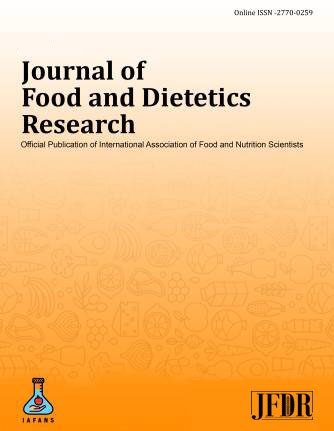Lepidium sativum L. (Garden Cress) seed mucilage: Quantitative Assessment (Total Phenols, Flavonoids and Tannins) and FT-IR Analysis
DOI:
https://doi.org/10.48165/jfdr.2025.5.1.3Keywords:
Lepidium sativum, , Hydrocolloids, Phenolic compounds, Antioxidants, Flavonoids, Tannins, FT-IRAbstract
Objectives: Lepidium sativum L. (Garden Cress) is an herb of Brassicaceae family growing in warm climates. The seeds contain mucilaginous compounds that are known to have bioactive properties. In the present investigation, extraction of Lepidiumsativum L. seed mucilage was followed by preliminary screening for carbohydrates, protein, mucilage, and qualitative and quantitative assessment of phytochemicals viz. total phenols, total flavonoids and tannin content. The extracted mucilage was also subjected to FT-IR analysis.
Methods: Extraction of seeds of L.sativum was performed and it is dried at 60⁰C for 6-8 hrs, followed by qualitative tests for carbohydrates, protein, mucilage and phytochemicals. The total phenols were estimated using Folin Ciocalteu method, total flavonoids using Aluminium chloride method and tannin content using Folin Denis method. The FT-IR spectra was obtained using the KBr-pellet technique.
Results: The screening tests showed the presence of carbohydrates, amino acids and phytochemicals. The total phenolic, flavonoid and tannin content estimated was 109±1.8 mgGAE/100 g, 96.2 ± 2.4 mgQE/100 g and 87.4 ± 3.2 mgTAE/100 g respectively. The FT-IR spectra of mucilage showed the presence of hydroxyl groups, carbonyl groups and confirm the region for carbohydrates and protein.
Conclusion: The phytochemical composition of garden cress seed mucilage can be a vital element in food functions which could strengthen the gum structure, improve food and gum interactions and enhance the shelf- life stability. In conclusion, garden cress mucilage appears to have distinct health benefits with added advantages as efficient additive in food products.
Downloads
References
1. Sakran, M., Selim, Y., & Zidan, N. (2014). A new isoflavonoid from seeds of Lepidium sativum L. and its protective effect on hepatotoxicity induced by paracetamol in male rats. Molecules, 19(10), 15440-15451.
2. Prajapati, V. D., Maheriya, P. M., Jani, G. K., Patil, P. D., & Patel, B. N. (2014). Lepidium sativum Linn.: A current addition to the family of mucilage and its applications. International journal of biological macromolecules, 65, 72-80.
3. Bedassa, T., Andargie, M., & Eshete, M. (2013). Genetic variability and association among yield, yield related traits and oil content in Ethiopian garden cress (Lepidium sativum L.) genotypes. Journal of Plant Breeding and Crop Science, 5(7), 141-149.
4. Gupta, R., & Choudhary, P. (2020). Botanical description of garden cress (Lepidium sativum L.) plant and physical characteristics of its seeds. Journal of Pharmacognosy and Phytochemistry, 9(5), 2424-2428.
5. Attia, E. S., Amer, A. H., & Hasanein, M. A. (2019). The hypoglycaemic and antioxidant activities of garden cress (Lepidium sativum L.) seed on alloxan-induced diabetic male rats. Natural product research, 33(6), 901-905.
6. Vazifeh, S., Kananpour, P., Khalilpour, M., Eisalou, S. V., & Hamblin, M. R. (2022). Anti‐inflammatory and Immunomodulatory Properties of Lepidium sativum. BioMed Research International, 2022(1), 3645038.
7. Wadhwa, S., Panwar, M.S., Agrawal, A., Saini, N., & Patidar, L.N.(2012). A review on pharmacognostical study of Lepidium sativum. Advance Research in Pharmaceuticals and Biologicals2 (IV), 316–323.
8. Baregama, C., & Goyal, A. (2019). Phytoconstituents, pharmacological activity, and medicinal use of Lepidium sativum Linn.: A review. Asian J Pharm Clin Res, 12(4), 45-50
9. Karazhiyan, H., Razavi, S.M.A., & Phillips, G.O.(2011a). Extraction optimization of a hydrocolloid extract from cress seed (Lepidium sativum) using response surface methodology. Food Hydrocolloids, 25, 915–920.
10. Cui, S.W. (2001). Polysaccharide Gums from Agricultural Products: Processing, Structures and Functionality (1st ed.). CRC Press. https://doi.org/10.1201/9781482279016
11. Khandelwal, K.R., (2008), Practical Pharmacognosy, (19th Edition)Pragati Books Pvt. Ltd.
12. Siddhu N, Saxena J (2017). Quantification of the total phenolic and total flavonoid content of extracts of Tagetes erecta flowers. Asian Journal of Pharmaceutical and Clinical Research, 10(6), 328-330. https://europub.co.uk/articles/-A-605361
13. Zou, Y.; Lu, Y.; Wei, D. Antioxidant activity of flavonoid-rich extract of Hypericum perforatum L. In vitro. J. Agric. Food Chem. 2004, 52, 5032–5039.
14. Rana, S. S., Tiwari, S., Gupta, N., Tripathi, M. K., Tripathi, N., Singh, S., & Bhagyawant, S. S. (2023). Validating the Nutraceutical Significance of Minor Millets by Employing Nutritional–Antinutritional Profiling. Life, 13(9), 1918.
15. Tadele, G. (2019). Phytochemical screening, determination of phenolic content, and antioxidant activity of garden cress (Lepidium sativum) seed varieties grown in three zones of Amhara region, Ethiopia
16. Chatoui, K., Talbaoui, A., Khallouki, F., & Filali- Zegzouti, Y. (2016). Phytochemical screening and antioxidant activity of Lepidium sativum seeds. Journal of Materials and Environmental Science, 7(8), 3102-3109.
17. Zia-Ul-Haq, M., Ahmad, S., Calani, L., Mazzeo, T., Del Rio, D., Pellegrini, N., & De Feo, V. (2012). Compositional Study and Antioxidant Potential of Ipomoea hederacea Jacq. And Lepidium sativum L. Seeds. Molecules, 17(9), 10306-10321. https://doi.org/10.3390/molecules170910306
18. Ahmad, R., Mujeeb, M., Anwar, F., Husain, A., Ahmad, A., Sharma, S. 2015: Pharmacognostical and phytochemical analysis of Lepidium sativum L. seeds. International Current Pharmaceutical Journal, 4(10), 442-446.
19. Ahmed, M.A., Eldanasoury, M.M., El-khamissi, H., & Taie, H.A. (2023). Phytochemicals, Phenolic Compounds and Antioxidant Activity of Garden cress (Lepidium sativum L.) seeds. Al-Azhar Journal of Agricultural Research.
20. Turkoğlu, M., Kılıç, S., Pekmezci, E., & Kartal, M. (2018). Evaluating Anti-inflammatory and Antiandrogenic Effects of Garden Cress (Lepidium sativum L.) in HaCaT cells. Records of Natural Products.
21. Balasundaram, N., Sundram, K., Samman, S., 2006. Phenolic compounds in plants and agri-industrial by-products: antioxidant activity, occurrence, and potential uses. Food Chemistry. 99, 191–203. https://doi.org/10.1016/j.foodchem.2005.07.042.
22. Velderrain-Rodríguez, G.R.; Palafox-Carlos, H.; Wall-Medrano, A.; Ayala Zavala, J.F.; Chen, C.-Y.O.; Robles-Sanchez, M.; Astiazaran-García, H.; Alvarez-Parrilla, E.; González-Aguilar, G.A. Phenolic compounds: Their journey after intake. Food Funct. 2014, 5, 189–197.
23. Lin, D., Xiao, M., Zhao, J., Li, Z., Xing, B., Li, X., Kong, M., Li, L., Zhang, Q., Liu, Y., Chen, H., Qin, W., Wu, H., & Chen, S. (2016). An Overview of Plant Phenolic Compounds and Their Importance in Human Nutrition and Management of Type 2 Diabetes. Molecules (Basel, Switzerland), 21(10), 1374. https://doi.org/10.3390/molecules21101374
24. Deshmukh, V. N., Yadav, B. V., & Badole, S. L. (2017). Evaluation of phytochemicals in Lepidium sativum (garden cress). International Journal of Pharma Sciences and Research, 8(5), 15-20.
25. Lafay, S., Gil-Izquierdo, A., 2008. Bioavailability of phenolic acids. Phytochemistry Reviews. 7, 301–311. https://doi.org/10.1007/s11101-007-9077-x.
26. Milena, Morandi, Vuolo.,Verena, Silva, Lima., Verena, Silva, Lima., Mário, Roberto, Maróstica, Júnior. (2019). Phenolic Compounds: Structure, Classification, and Antioxidant Power. 33-50.
27. Ferrer, J.L., Austin, M.B., Stewart, C., Noel, J.P., 2008. Structure and function of enzymes involved in the biosynthesis of phenylpropanoids. Plant Physiology and Biochemistry. 46, 356–370. https://doi.org/10.1016/j.plaphy.2007.12.009.
28. Al-Snafi, A.E. 2019: Chemical Constituents and Pharmacological Effects of Lepidium Sativum-A. Int J Curr Pharm Res, 11(6), 1-10.
29. Ghante, M.H., Badole, S.L., Bodhankar, S.L. 2011: Health benefits of garden cress (Lepidium sativum Linn.) seed extracts. In Nuts and seeds in health and disease prevention (pp. 521-525). Academic Press.
30. Tsao, R. (2010). Chemistry and biochemistry of dietary polyphenols. Nutrients, 2(12), 1231-1246. https://doi.org/10.3390/nu2121231
31. Williamson, G. (2017). The role of polyphenols in modern nutrition. Nutrition Bulletin, 42(3), 226-235. https://doi.org/10.1111/nbu.122783
32. Chung, K. T., Wong, T. Y., Wei, C. I., Huang, Y. W., & Lin, Y. (1998). Tannins and human health: A review. Critical Reviews in Food Science and Nutrition, 38(6), 421-464. https://doi.org/10.1080/10408699891274273
33. Chikezie, P. C., Ibegbulem, C. O., & Mbagwu, F. N. (2015). Bioactive principles from medicinal plants. Research Journal of Phytochemistry, 9(3), 88-115. https://doi.org/10.3923/rjphyto.2015.88.115
34. Razavi, S. M. A., Cui, S. W., Guo, Q., & Ding, H. (2014). Some physicochemical properties of sage (Salvia macrosiphon) seed gum. Food Hydrocolloids, 35, 453–462
35. Razmkhah, Somayeh & Razavi, Seyed & Mohammadifar, Mohammad Amin & Ale, Marcel & Ahmadi Gavlighi, Hassan. (2016). Protein-free cress seed (Lepidium sativum) gum: Physicochemical characterization and rheological properties. Carbohydrate Polymers. 153. 10.1016/j.carbpol.2016.07.086.
36. Naji-Tabasi, S., Razavi, S. M. A., Mohebbi, M., & Malaekeh-Nikouei, B. (2016). New studies on basil (Ocimum bacilicum L.) seed gum: Part I – Fractionation, physicochemical and surface activity characterization. Food Hydrocolloids, 52, 350–358
37. Jindal, M., Rana, V., Kumar, V., Singh, R. S., Kennedy, J. F., & Tiwary, A. K. (2013). Sulfation of Aegle marmelos gum: Synthesis, physico-chemical and functional characterization. Carbohydrate Polymers, 92, 1660–1668.
38. Kang, J., Cui, S. W., Chen, J., Phillips, G. O., Wu, Y., & Wang, Q. (2011). New studies on gum ghatti (Anogeissus latifolia) part I. fractionation, chemical and physical characterization of the gum. Food Hydrocolloids, 25, 1984–1990.
39. Guo, Y.; Ma, C.; Xu, Y.; Du, L.; Yang, X. Food Gels Based on Polysaccharide and Protein: Preparation, Formation Mechanisms, and Delivery of Bioactive Substances. Gels 2024, 10, 735. https://doi.org/10.3390/gels10110735




